Evaluating Leadership Theories and Management Operations at M&S
VerifiedAdded on 2020/06/04
|16
|4527
|33
Report
AI Summary
This report examines leadership and management principles within the context of Marks & Spencer (M&S). It begins with an introduction to the roles and characteristics of leaders and managers, differentiating their functions and responsibilities. The report delves into various leadership theories, including trait theory, behavioral theory, human relations theory, and chaos theory, analyzing their application in a management setting. It explores the functions of a manager, such as planning, organizing, staffing, coordinating, and controlling, highlighting their importance in achieving organizational goals. The report also addresses how managers and leaders should handle different situations such as lasting situations, moderate situations and marketing change situations. Finally, the report discusses different leadership approaches like systematic leadership and contingency leadership. The report provides a comprehensive overview of leadership and management, offering insights into effective strategies for organizational success.
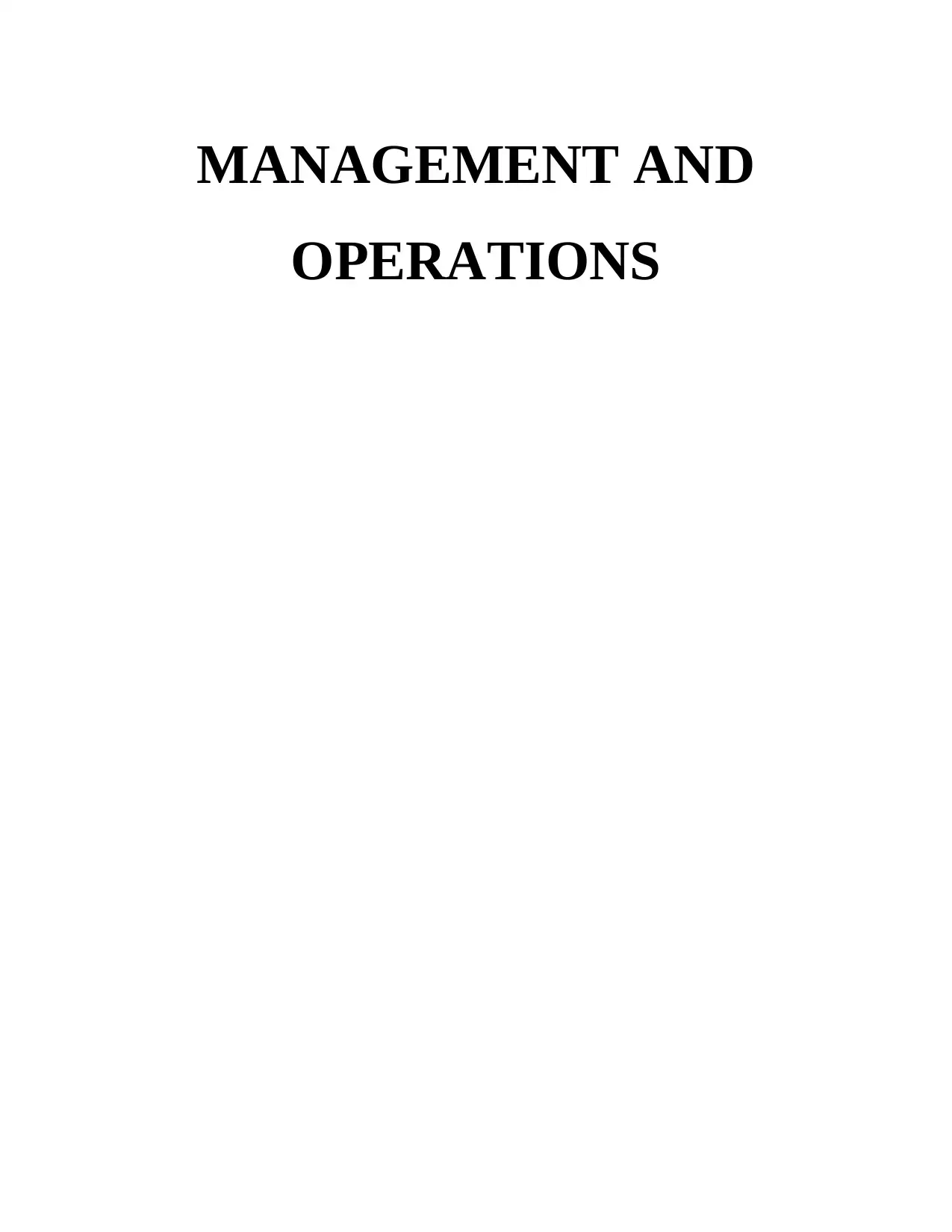
MANAGEMENT AND
OPERATIONS
OPERATIONS
Paraphrase This Document
Need a fresh take? Get an instant paraphrase of this document with our AI Paraphraser
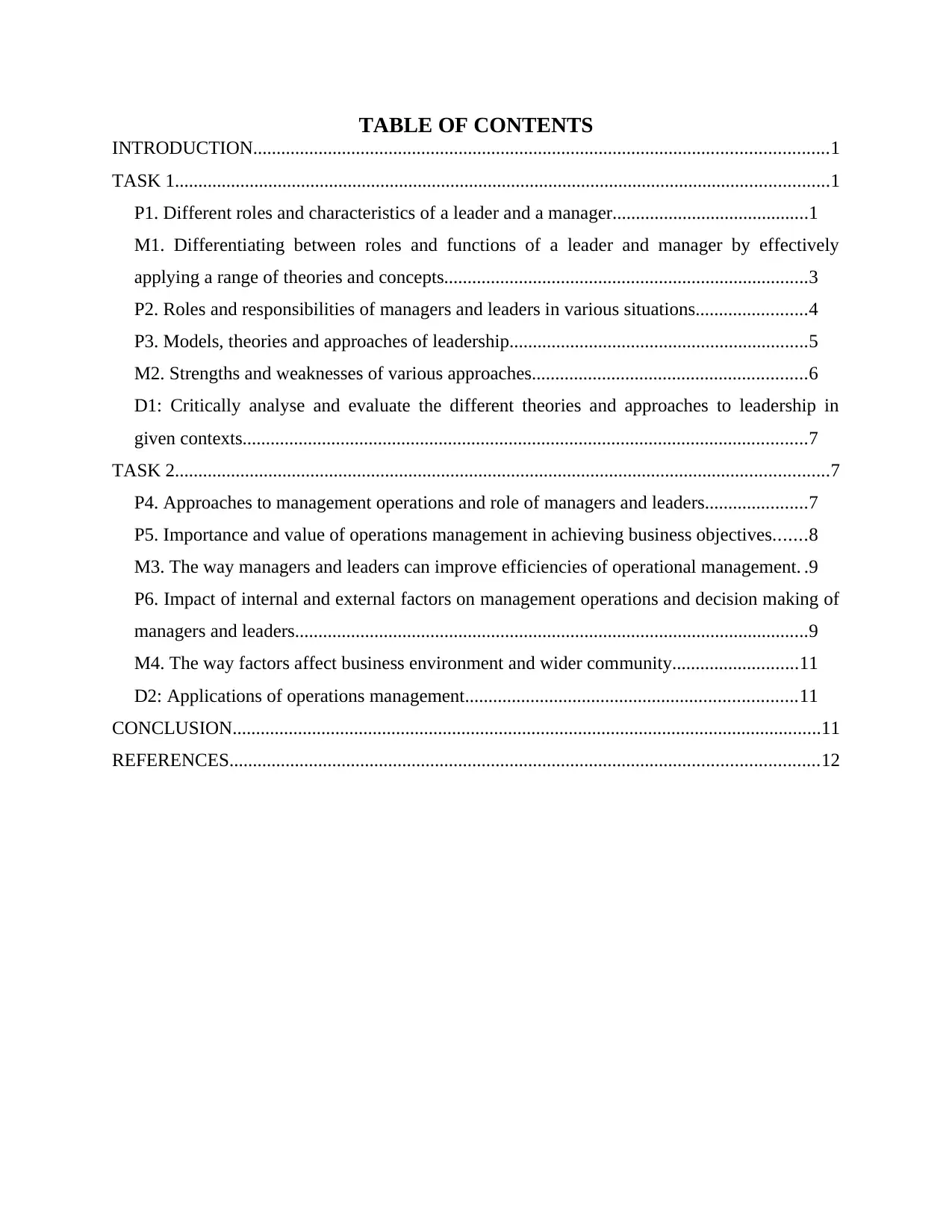
TABLE OF CONTENTS
INTRODUCTION...........................................................................................................................1
TASK 1............................................................................................................................................1
P1. Different roles and characteristics of a leader and a manager..........................................1
M1. Differentiating between roles and functions of a leader and manager by effectively
applying a range of theories and concepts..............................................................................3
P2. Roles and responsibilities of managers and leaders in various situations........................4
P3. Models, theories and approaches of leadership................................................................5
M2. Strengths and weaknesses of various approaches...........................................................6
D1: Critically analyse and evaluate the different theories and approaches to leadership in
given contexts.........................................................................................................................7
TASK 2............................................................................................................................................7
P4. Approaches to management operations and role of managers and leaders......................7
P5. Importance and value of operations management in achieving business objectives.......8
M3. The way managers and leaders can improve efficiencies of operational management. .9
P6. Impact of internal and external factors on management operations and decision making of
managers and leaders..............................................................................................................9
M4. The way factors affect business environment and wider community...........................11
D2: Applications of operations management.......................................................................11
CONCLUSION..............................................................................................................................11
REFERENCES..............................................................................................................................12
INTRODUCTION...........................................................................................................................1
TASK 1............................................................................................................................................1
P1. Different roles and characteristics of a leader and a manager..........................................1
M1. Differentiating between roles and functions of a leader and manager by effectively
applying a range of theories and concepts..............................................................................3
P2. Roles and responsibilities of managers and leaders in various situations........................4
P3. Models, theories and approaches of leadership................................................................5
M2. Strengths and weaknesses of various approaches...........................................................6
D1: Critically analyse and evaluate the different theories and approaches to leadership in
given contexts.........................................................................................................................7
TASK 2............................................................................................................................................7
P4. Approaches to management operations and role of managers and leaders......................7
P5. Importance and value of operations management in achieving business objectives.......8
M3. The way managers and leaders can improve efficiencies of operational management. .9
P6. Impact of internal and external factors on management operations and decision making of
managers and leaders..............................................................................................................9
M4. The way factors affect business environment and wider community...........................11
D2: Applications of operations management.......................................................................11
CONCLUSION..............................................................................................................................11
REFERENCES..............................................................................................................................12
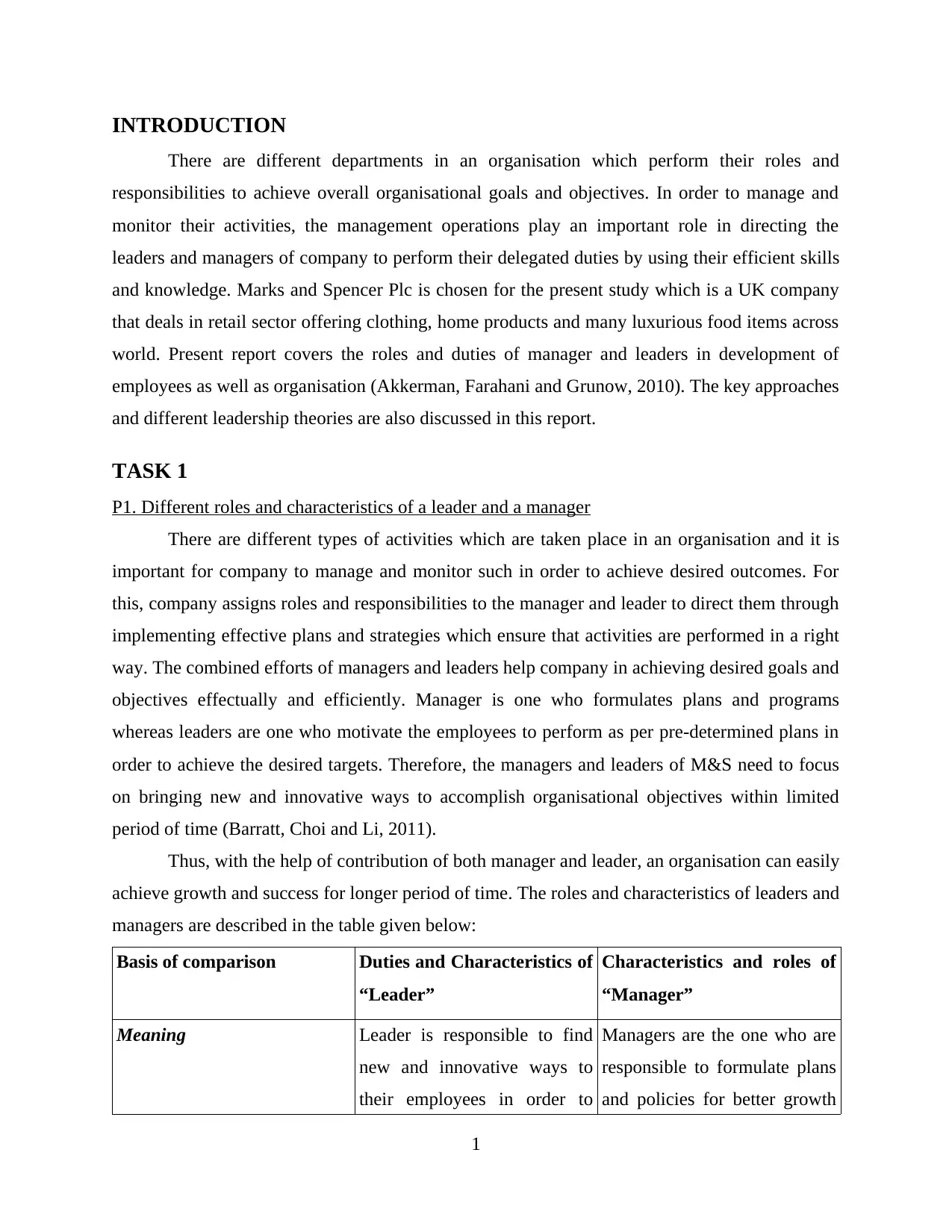
INTRODUCTION
There are different departments in an organisation which perform their roles and
responsibilities to achieve overall organisational goals and objectives. In order to manage and
monitor their activities, the management operations play an important role in directing the
leaders and managers of company to perform their delegated duties by using their efficient skills
and knowledge. Marks and Spencer Plc is chosen for the present study which is a UK company
that deals in retail sector offering clothing, home products and many luxurious food items across
world. Present report covers the roles and duties of manager and leaders in development of
employees as well as organisation (Akkerman, Farahani and Grunow, 2010). The key approaches
and different leadership theories are also discussed in this report.
TASK 1
P1. Different roles and characteristics of a leader and a manager
There are different types of activities which are taken place in an organisation and it is
important for company to manage and monitor such in order to achieve desired outcomes. For
this, company assigns roles and responsibilities to the manager and leader to direct them through
implementing effective plans and strategies which ensure that activities are performed in a right
way. The combined efforts of managers and leaders help company in achieving desired goals and
objectives effectually and efficiently. Manager is one who formulates plans and programs
whereas leaders are one who motivate the employees to perform as per pre-determined plans in
order to achieve the desired targets. Therefore, the managers and leaders of M&S need to focus
on bringing new and innovative ways to accomplish organisational objectives within limited
period of time (Barratt, Choi and Li, 2011).
Thus, with the help of contribution of both manager and leader, an organisation can easily
achieve growth and success for longer period of time. The roles and characteristics of leaders and
managers are described in the table given below:
Basis of comparison Duties and Characteristics of
“Leader”
Characteristics and roles of
“Manager”
Meaning Leader is responsible to find
new and innovative ways to
their employees in order to
Managers are the one who are
responsible to formulate plans
and policies for better growth
1
There are different departments in an organisation which perform their roles and
responsibilities to achieve overall organisational goals and objectives. In order to manage and
monitor their activities, the management operations play an important role in directing the
leaders and managers of company to perform their delegated duties by using their efficient skills
and knowledge. Marks and Spencer Plc is chosen for the present study which is a UK company
that deals in retail sector offering clothing, home products and many luxurious food items across
world. Present report covers the roles and duties of manager and leaders in development of
employees as well as organisation (Akkerman, Farahani and Grunow, 2010). The key approaches
and different leadership theories are also discussed in this report.
TASK 1
P1. Different roles and characteristics of a leader and a manager
There are different types of activities which are taken place in an organisation and it is
important for company to manage and monitor such in order to achieve desired outcomes. For
this, company assigns roles and responsibilities to the manager and leader to direct them through
implementing effective plans and strategies which ensure that activities are performed in a right
way. The combined efforts of managers and leaders help company in achieving desired goals and
objectives effectually and efficiently. Manager is one who formulates plans and programs
whereas leaders are one who motivate the employees to perform as per pre-determined plans in
order to achieve the desired targets. Therefore, the managers and leaders of M&S need to focus
on bringing new and innovative ways to accomplish organisational objectives within limited
period of time (Barratt, Choi and Li, 2011).
Thus, with the help of contribution of both manager and leader, an organisation can easily
achieve growth and success for longer period of time. The roles and characteristics of leaders and
managers are described in the table given below:
Basis of comparison Duties and Characteristics of
“Leader”
Characteristics and roles of
“Manager”
Meaning Leader is responsible to find
new and innovative ways to
their employees in order to
Managers are the one who are
responsible to formulate plans
and policies for better growth
1
⊘ This is a preview!⊘
Do you want full access?
Subscribe today to unlock all pages.

Trusted by 1+ million students worldwide
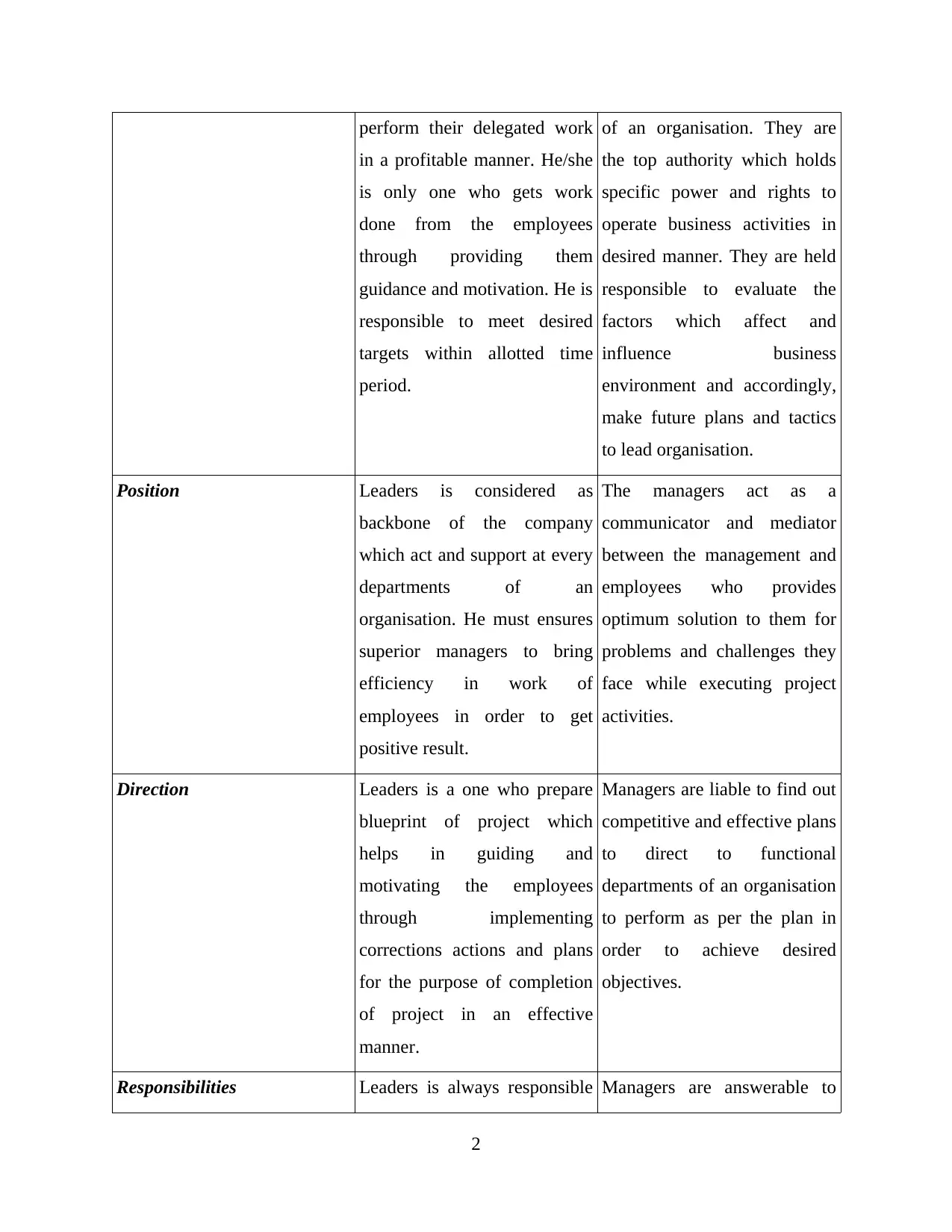
perform their delegated work
in a profitable manner. He/she
is only one who gets work
done from the employees
through providing them
guidance and motivation. He is
responsible to meet desired
targets within allotted time
period.
of an organisation. They are
the top authority which holds
specific power and rights to
operate business activities in
desired manner. They are held
responsible to evaluate the
factors which affect and
influence business
environment and accordingly,
make future plans and tactics
to lead organisation.
Position Leaders is considered as
backbone of the company
which act and support at every
departments of an
organisation. He must ensures
superior managers to bring
efficiency in work of
employees in order to get
positive result.
The managers act as a
communicator and mediator
between the management and
employees who provides
optimum solution to them for
problems and challenges they
face while executing project
activities.
Direction Leaders is a one who prepare
blueprint of project which
helps in guiding and
motivating the employees
through implementing
corrections actions and plans
for the purpose of completion
of project in an effective
manner.
Managers are liable to find out
competitive and effective plans
to direct to functional
departments of an organisation
to perform as per the plan in
order to achieve desired
objectives.
Responsibilities Leaders is always responsible Managers are answerable to
2
in a profitable manner. He/she
is only one who gets work
done from the employees
through providing them
guidance and motivation. He is
responsible to meet desired
targets within allotted time
period.
of an organisation. They are
the top authority which holds
specific power and rights to
operate business activities in
desired manner. They are held
responsible to evaluate the
factors which affect and
influence business
environment and accordingly,
make future plans and tactics
to lead organisation.
Position Leaders is considered as
backbone of the company
which act and support at every
departments of an
organisation. He must ensures
superior managers to bring
efficiency in work of
employees in order to get
positive result.
The managers act as a
communicator and mediator
between the management and
employees who provides
optimum solution to them for
problems and challenges they
face while executing project
activities.
Direction Leaders is a one who prepare
blueprint of project which
helps in guiding and
motivating the employees
through implementing
corrections actions and plans
for the purpose of completion
of project in an effective
manner.
Managers are liable to find out
competitive and effective plans
to direct to functional
departments of an organisation
to perform as per the plan in
order to achieve desired
objectives.
Responsibilities Leaders is always responsible Managers are answerable to
2
Paraphrase This Document
Need a fresh take? Get an instant paraphrase of this document with our AI Paraphraser
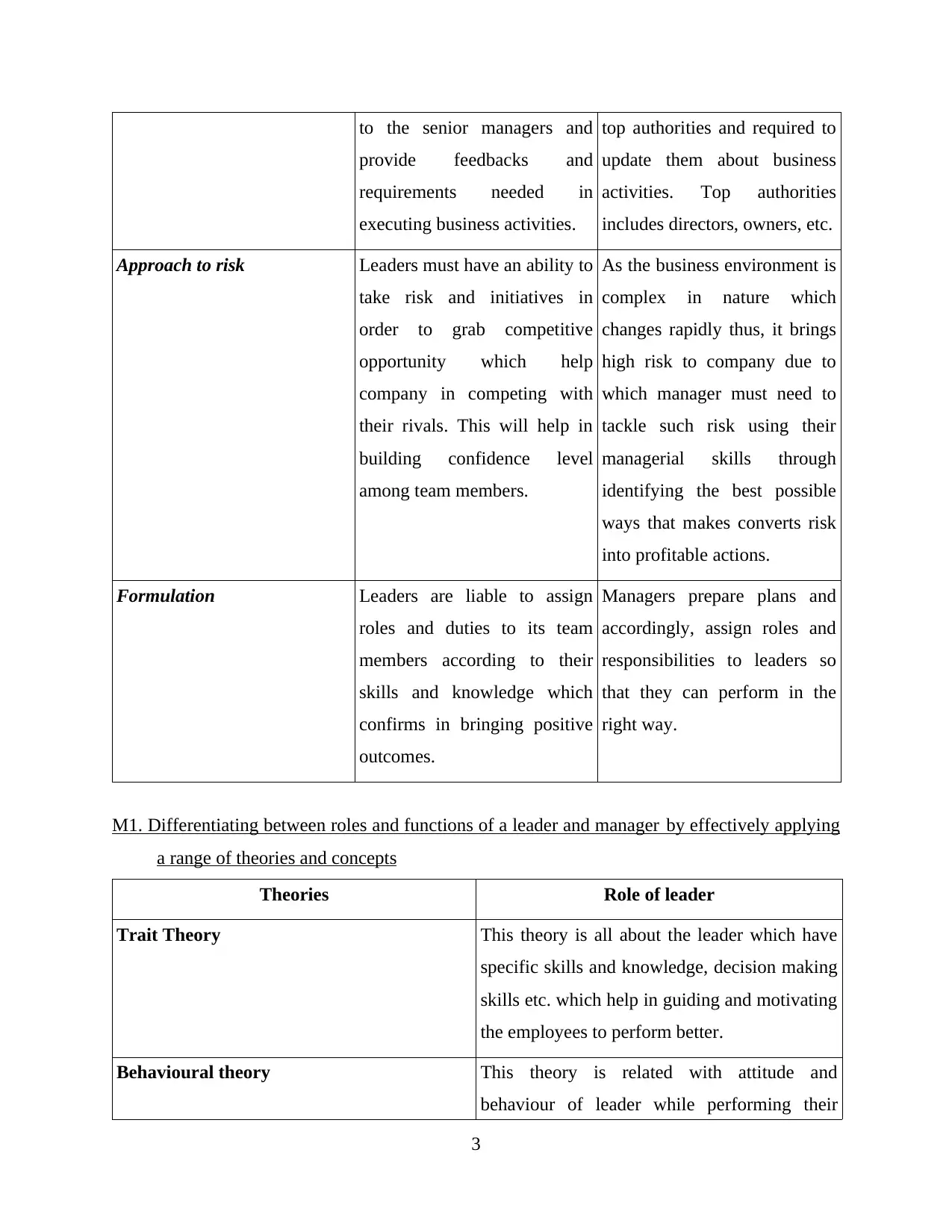
to the senior managers and
provide feedbacks and
requirements needed in
executing business activities.
top authorities and required to
update them about business
activities. Top authorities
includes directors, owners, etc.
Approach to risk Leaders must have an ability to
take risk and initiatives in
order to grab competitive
opportunity which help
company in competing with
their rivals. This will help in
building confidence level
among team members.
As the business environment is
complex in nature which
changes rapidly thus, it brings
high risk to company due to
which manager must need to
tackle such risk using their
managerial skills through
identifying the best possible
ways that makes converts risk
into profitable actions.
Formulation Leaders are liable to assign
roles and duties to its team
members according to their
skills and knowledge which
confirms in bringing positive
outcomes.
Managers prepare plans and
accordingly, assign roles and
responsibilities to leaders so
that they can perform in the
right way.
M1. Differentiating between roles and functions of a leader and manager by effectively applying
a range of theories and concepts
Theories Role of leader
Trait Theory This theory is all about the leader which have
specific skills and knowledge, decision making
skills etc. which help in guiding and motivating
the employees to perform better.
Behavioural theory This theory is related with attitude and
behaviour of leader while performing their
3
provide feedbacks and
requirements needed in
executing business activities.
top authorities and required to
update them about business
activities. Top authorities
includes directors, owners, etc.
Approach to risk Leaders must have an ability to
take risk and initiatives in
order to grab competitive
opportunity which help
company in competing with
their rivals. This will help in
building confidence level
among team members.
As the business environment is
complex in nature which
changes rapidly thus, it brings
high risk to company due to
which manager must need to
tackle such risk using their
managerial skills through
identifying the best possible
ways that makes converts risk
into profitable actions.
Formulation Leaders are liable to assign
roles and duties to its team
members according to their
skills and knowledge which
confirms in bringing positive
outcomes.
Managers prepare plans and
accordingly, assign roles and
responsibilities to leaders so
that they can perform in the
right way.
M1. Differentiating between roles and functions of a leader and manager by effectively applying
a range of theories and concepts
Theories Role of leader
Trait Theory This theory is all about the leader which have
specific skills and knowledge, decision making
skills etc. which help in guiding and motivating
the employees to perform better.
Behavioural theory This theory is related with attitude and
behaviour of leader while performing their
3
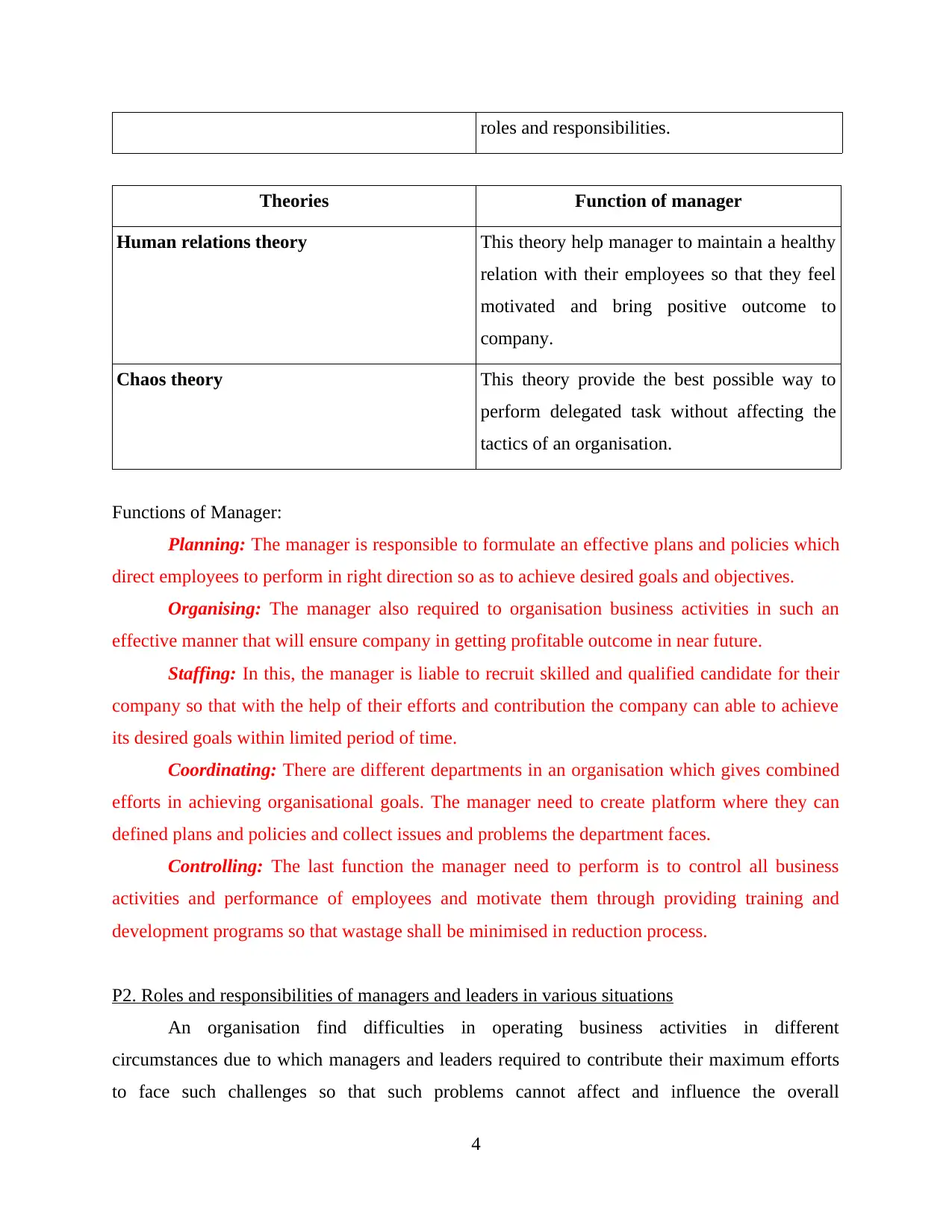
roles and responsibilities.
Theories Function of manager
Human relations theory This theory help manager to maintain a healthy
relation with their employees so that they feel
motivated and bring positive outcome to
company.
Chaos theory This theory provide the best possible way to
perform delegated task without affecting the
tactics of an organisation.
Functions of Manager:
Planning: The manager is responsible to formulate an effective plans and policies which
direct employees to perform in right direction so as to achieve desired goals and objectives.
Organising: The manager also required to organisation business activities in such an
effective manner that will ensure company in getting profitable outcome in near future.
Staffing: In this, the manager is liable to recruit skilled and qualified candidate for their
company so that with the help of their efforts and contribution the company can able to achieve
its desired goals within limited period of time.
Coordinating: There are different departments in an organisation which gives combined
efforts in achieving organisational goals. The manager need to create platform where they can
defined plans and policies and collect issues and problems the department faces.
Controlling: The last function the manager need to perform is to control all business
activities and performance of employees and motivate them through providing training and
development programs so that wastage shall be minimised in reduction process.
P2. Roles and responsibilities of managers and leaders in various situations
An organisation find difficulties in operating business activities in different
circumstances due to which managers and leaders required to contribute their maximum efforts
to face such challenges so that such problems cannot affect and influence the overall
4
Theories Function of manager
Human relations theory This theory help manager to maintain a healthy
relation with their employees so that they feel
motivated and bring positive outcome to
company.
Chaos theory This theory provide the best possible way to
perform delegated task without affecting the
tactics of an organisation.
Functions of Manager:
Planning: The manager is responsible to formulate an effective plans and policies which
direct employees to perform in right direction so as to achieve desired goals and objectives.
Organising: The manager also required to organisation business activities in such an
effective manner that will ensure company in getting profitable outcome in near future.
Staffing: In this, the manager is liable to recruit skilled and qualified candidate for their
company so that with the help of their efforts and contribution the company can able to achieve
its desired goals within limited period of time.
Coordinating: There are different departments in an organisation which gives combined
efforts in achieving organisational goals. The manager need to create platform where they can
defined plans and policies and collect issues and problems the department faces.
Controlling: The last function the manager need to perform is to control all business
activities and performance of employees and motivate them through providing training and
development programs so that wastage shall be minimised in reduction process.
P2. Roles and responsibilities of managers and leaders in various situations
An organisation find difficulties in operating business activities in different
circumstances due to which managers and leaders required to contribute their maximum efforts
to face such challenges so that such problems cannot affect and influence the overall
4
⊘ This is a preview!⊘
Do you want full access?
Subscribe today to unlock all pages.

Trusted by 1+ million students worldwide
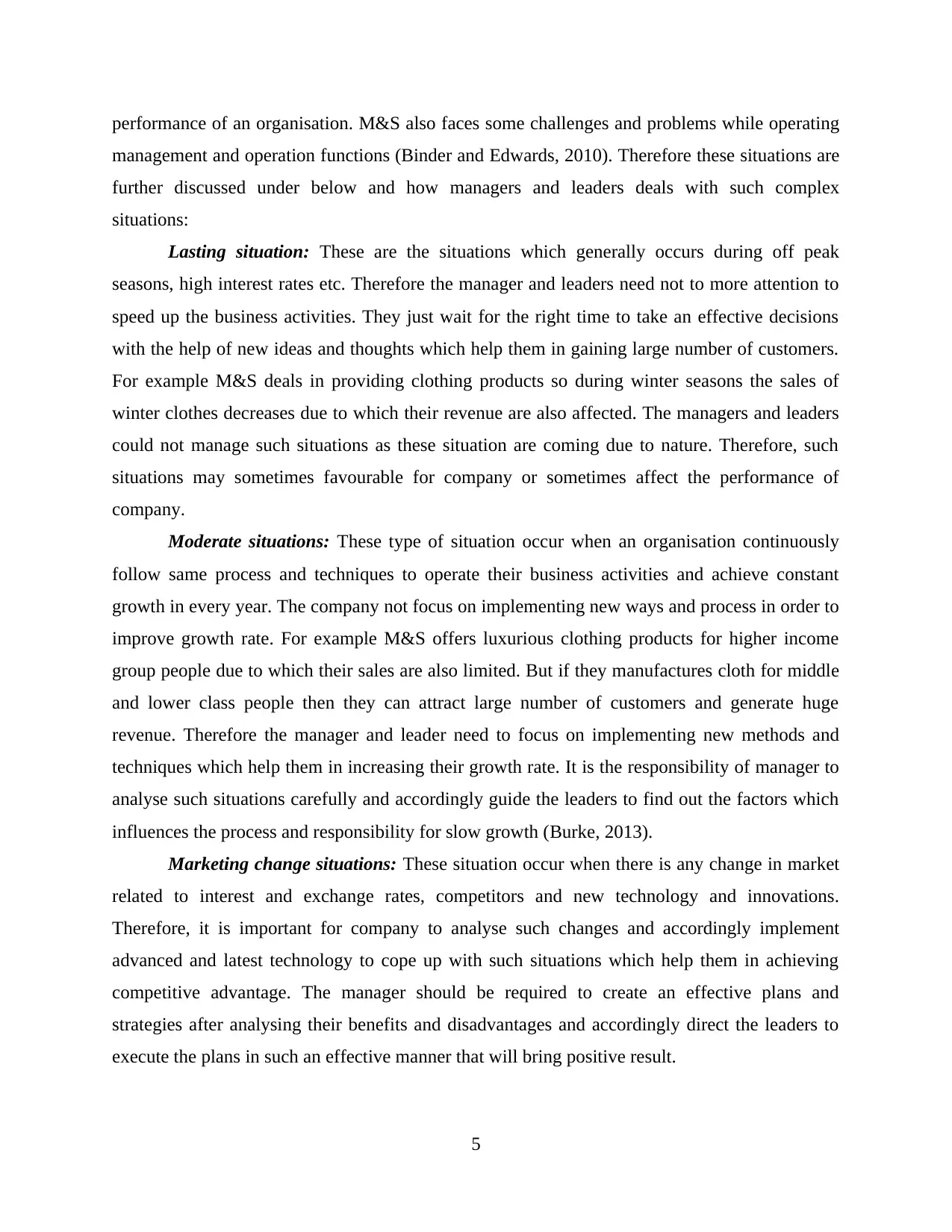
performance of an organisation. M&S also faces some challenges and problems while operating
management and operation functions (Binder and Edwards, 2010). Therefore these situations are
further discussed under below and how managers and leaders deals with such complex
situations:
Lasting situation: These are the situations which generally occurs during off peak
seasons, high interest rates etc. Therefore the manager and leaders need not to more attention to
speed up the business activities. They just wait for the right time to take an effective decisions
with the help of new ideas and thoughts which help them in gaining large number of customers.
For example M&S deals in providing clothing products so during winter seasons the sales of
winter clothes decreases due to which their revenue are also affected. The managers and leaders
could not manage such situations as these situation are coming due to nature. Therefore, such
situations may sometimes favourable for company or sometimes affect the performance of
company.
Moderate situations: These type of situation occur when an organisation continuously
follow same process and techniques to operate their business activities and achieve constant
growth in every year. The company not focus on implementing new ways and process in order to
improve growth rate. For example M&S offers luxurious clothing products for higher income
group people due to which their sales are also limited. But if they manufactures cloth for middle
and lower class people then they can attract large number of customers and generate huge
revenue. Therefore the manager and leader need to focus on implementing new methods and
techniques which help them in increasing their growth rate. It is the responsibility of manager to
analyse such situations carefully and accordingly guide the leaders to find out the factors which
influences the process and responsibility for slow growth (Burke, 2013).
Marketing change situations: These situation occur when there is any change in market
related to interest and exchange rates, competitors and new technology and innovations.
Therefore, it is important for company to analyse such changes and accordingly implement
advanced and latest technology to cope up with such situations which help them in achieving
competitive advantage. The manager should be required to create an effective plans and
strategies after analysing their benefits and disadvantages and accordingly direct the leaders to
execute the plans in such an effective manner that will bring positive result.
5
management and operation functions (Binder and Edwards, 2010). Therefore these situations are
further discussed under below and how managers and leaders deals with such complex
situations:
Lasting situation: These are the situations which generally occurs during off peak
seasons, high interest rates etc. Therefore the manager and leaders need not to more attention to
speed up the business activities. They just wait for the right time to take an effective decisions
with the help of new ideas and thoughts which help them in gaining large number of customers.
For example M&S deals in providing clothing products so during winter seasons the sales of
winter clothes decreases due to which their revenue are also affected. The managers and leaders
could not manage such situations as these situation are coming due to nature. Therefore, such
situations may sometimes favourable for company or sometimes affect the performance of
company.
Moderate situations: These type of situation occur when an organisation continuously
follow same process and techniques to operate their business activities and achieve constant
growth in every year. The company not focus on implementing new ways and process in order to
improve growth rate. For example M&S offers luxurious clothing products for higher income
group people due to which their sales are also limited. But if they manufactures cloth for middle
and lower class people then they can attract large number of customers and generate huge
revenue. Therefore the manager and leader need to focus on implementing new methods and
techniques which help them in increasing their growth rate. It is the responsibility of manager to
analyse such situations carefully and accordingly guide the leaders to find out the factors which
influences the process and responsibility for slow growth (Burke, 2013).
Marketing change situations: These situation occur when there is any change in market
related to interest and exchange rates, competitors and new technology and innovations.
Therefore, it is important for company to analyse such changes and accordingly implement
advanced and latest technology to cope up with such situations which help them in achieving
competitive advantage. The manager should be required to create an effective plans and
strategies after analysing their benefits and disadvantages and accordingly direct the leaders to
execute the plans in such an effective manner that will bring positive result.
5
Paraphrase This Document
Need a fresh take? Get an instant paraphrase of this document with our AI Paraphraser
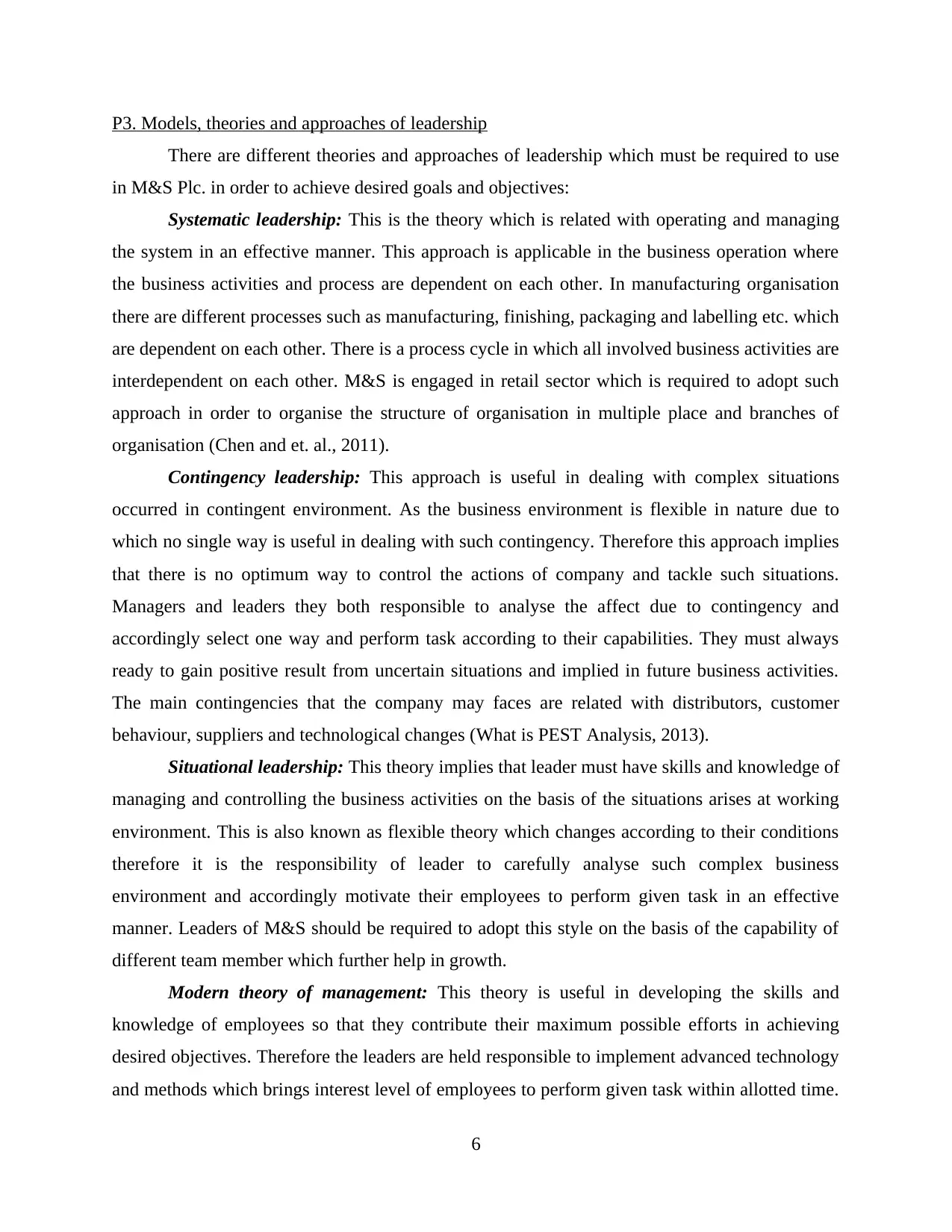
P3. Models, theories and approaches of leadership
There are different theories and approaches of leadership which must be required to use
in M&S Plc. in order to achieve desired goals and objectives:
Systematic leadership: This is the theory which is related with operating and managing
the system in an effective manner. This approach is applicable in the business operation where
the business activities and process are dependent on each other. In manufacturing organisation
there are different processes such as manufacturing, finishing, packaging and labelling etc. which
are dependent on each other. There is a process cycle in which all involved business activities are
interdependent on each other. M&S is engaged in retail sector which is required to adopt such
approach in order to organise the structure of organisation in multiple place and branches of
organisation (Chen and et. al., 2011).
Contingency leadership: This approach is useful in dealing with complex situations
occurred in contingent environment. As the business environment is flexible in nature due to
which no single way is useful in dealing with such contingency. Therefore this approach implies
that there is no optimum way to control the actions of company and tackle such situations.
Managers and leaders they both responsible to analyse the affect due to contingency and
accordingly select one way and perform task according to their capabilities. They must always
ready to gain positive result from uncertain situations and implied in future business activities.
The main contingencies that the company may faces are related with distributors, customer
behaviour, suppliers and technological changes (What is PEST Analysis, 2013).
Situational leadership: This theory implies that leader must have skills and knowledge of
managing and controlling the business activities on the basis of the situations arises at working
environment. This is also known as flexible theory which changes according to their conditions
therefore it is the responsibility of leader to carefully analyse such complex business
environment and accordingly motivate their employees to perform given task in an effective
manner. Leaders of M&S should be required to adopt this style on the basis of the capability of
different team member which further help in growth.
Modern theory of management: This theory is useful in developing the skills and
knowledge of employees so that they contribute their maximum possible efforts in achieving
desired objectives. Therefore the leaders are held responsible to implement advanced technology
and methods which brings interest level of employees to perform given task within allotted time.
6
There are different theories and approaches of leadership which must be required to use
in M&S Plc. in order to achieve desired goals and objectives:
Systematic leadership: This is the theory which is related with operating and managing
the system in an effective manner. This approach is applicable in the business operation where
the business activities and process are dependent on each other. In manufacturing organisation
there are different processes such as manufacturing, finishing, packaging and labelling etc. which
are dependent on each other. There is a process cycle in which all involved business activities are
interdependent on each other. M&S is engaged in retail sector which is required to adopt such
approach in order to organise the structure of organisation in multiple place and branches of
organisation (Chen and et. al., 2011).
Contingency leadership: This approach is useful in dealing with complex situations
occurred in contingent environment. As the business environment is flexible in nature due to
which no single way is useful in dealing with such contingency. Therefore this approach implies
that there is no optimum way to control the actions of company and tackle such situations.
Managers and leaders they both responsible to analyse the affect due to contingency and
accordingly select one way and perform task according to their capabilities. They must always
ready to gain positive result from uncertain situations and implied in future business activities.
The main contingencies that the company may faces are related with distributors, customer
behaviour, suppliers and technological changes (What is PEST Analysis, 2013).
Situational leadership: This theory implies that leader must have skills and knowledge of
managing and controlling the business activities on the basis of the situations arises at working
environment. This is also known as flexible theory which changes according to their conditions
therefore it is the responsibility of leader to carefully analyse such complex business
environment and accordingly motivate their employees to perform given task in an effective
manner. Leaders of M&S should be required to adopt this style on the basis of the capability of
different team member which further help in growth.
Modern theory of management: This theory is useful in developing the skills and
knowledge of employees so that they contribute their maximum possible efforts in achieving
desired objectives. Therefore the leaders are held responsible to implement advanced technology
and methods which brings interest level of employees to perform given task within allotted time.
6
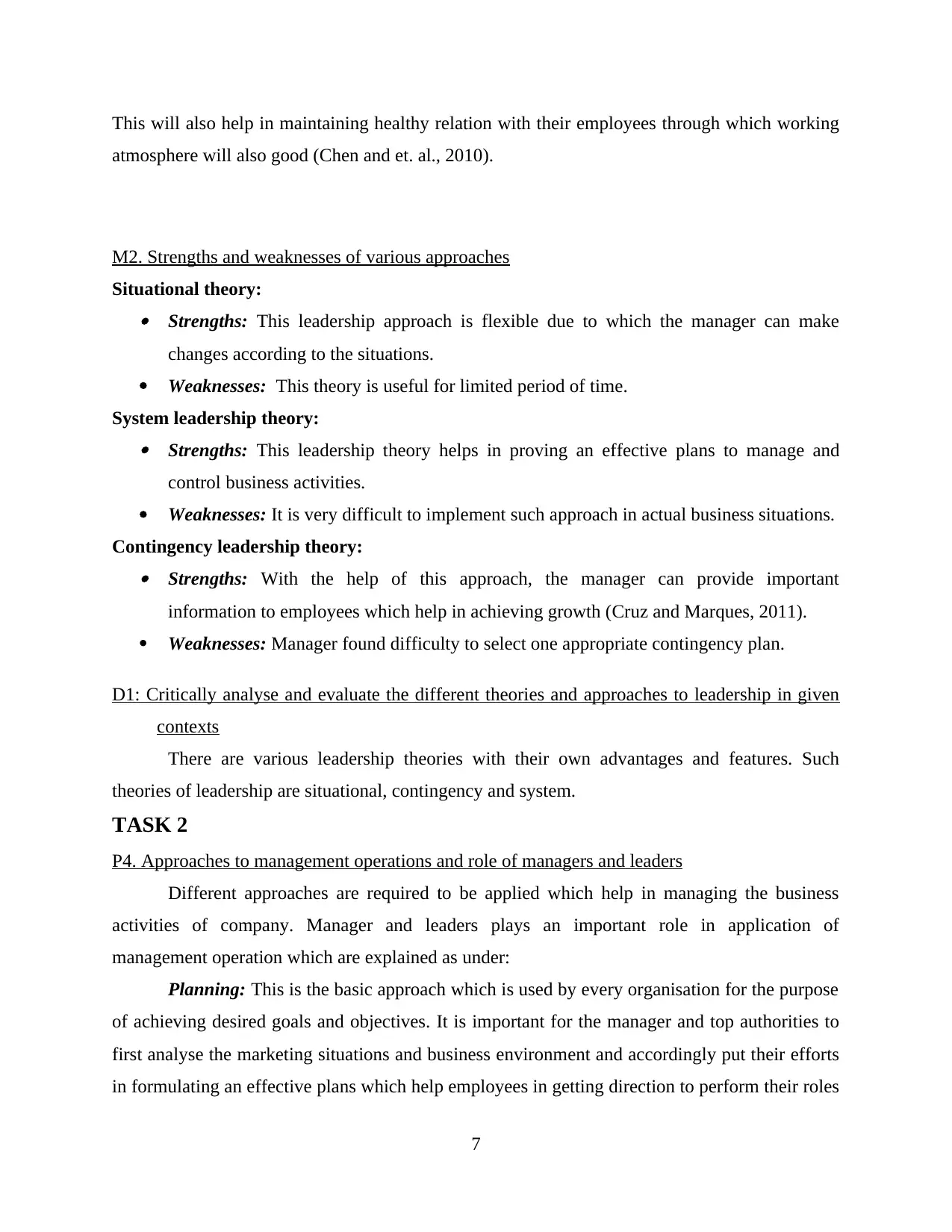
This will also help in maintaining healthy relation with their employees through which working
atmosphere will also good (Chen and et. al., 2010).
M2. Strengths and weaknesses of various approaches
Situational theory: Strengths: This leadership approach is flexible due to which the manager can make
changes according to the situations.
Weaknesses: This theory is useful for limited period of time.
System leadership theory: Strengths: This leadership theory helps in proving an effective plans to manage and
control business activities.
Weaknesses: It is very difficult to implement such approach in actual business situations.
Contingency leadership theory: Strengths: With the help of this approach, the manager can provide important
information to employees which help in achieving growth (Cruz and Marques, 2011).
Weaknesses: Manager found difficulty to select one appropriate contingency plan.
D1: Critically analyse and evaluate the different theories and approaches to leadership in given
contexts
There are various leadership theories with their own advantages and features. Such
theories of leadership are situational, contingency and system.
TASK 2
P4. Approaches to management operations and role of managers and leaders
Different approaches are required to be applied which help in managing the business
activities of company. Manager and leaders plays an important role in application of
management operation which are explained as under:
Planning: This is the basic approach which is used by every organisation for the purpose
of achieving desired goals and objectives. It is important for the manager and top authorities to
first analyse the marketing situations and business environment and accordingly put their efforts
in formulating an effective plans which help employees in getting direction to perform their roles
7
atmosphere will also good (Chen and et. al., 2010).
M2. Strengths and weaknesses of various approaches
Situational theory: Strengths: This leadership approach is flexible due to which the manager can make
changes according to the situations.
Weaknesses: This theory is useful for limited period of time.
System leadership theory: Strengths: This leadership theory helps in proving an effective plans to manage and
control business activities.
Weaknesses: It is very difficult to implement such approach in actual business situations.
Contingency leadership theory: Strengths: With the help of this approach, the manager can provide important
information to employees which help in achieving growth (Cruz and Marques, 2011).
Weaknesses: Manager found difficulty to select one appropriate contingency plan.
D1: Critically analyse and evaluate the different theories and approaches to leadership in given
contexts
There are various leadership theories with their own advantages and features. Such
theories of leadership are situational, contingency and system.
TASK 2
P4. Approaches to management operations and role of managers and leaders
Different approaches are required to be applied which help in managing the business
activities of company. Manager and leaders plays an important role in application of
management operation which are explained as under:
Planning: This is the basic approach which is used by every organisation for the purpose
of achieving desired goals and objectives. It is important for the manager and top authorities to
first analyse the marketing situations and business environment and accordingly put their efforts
in formulating an effective plans which help employees in getting direction to perform their roles
7
⊘ This is a preview!⊘
Do you want full access?
Subscribe today to unlock all pages.

Trusted by 1+ million students worldwide
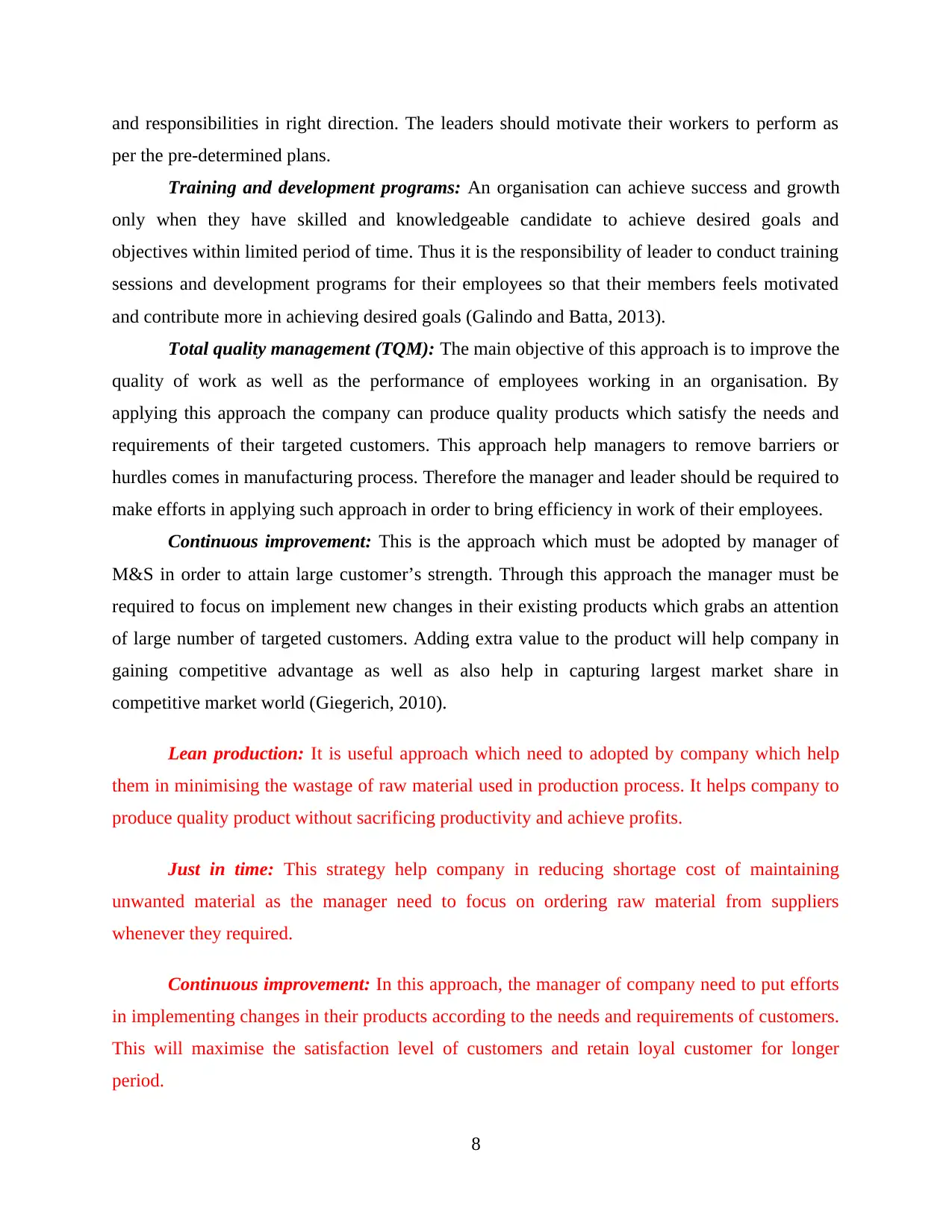
and responsibilities in right direction. The leaders should motivate their workers to perform as
per the pre-determined plans.
Training and development programs: An organisation can achieve success and growth
only when they have skilled and knowledgeable candidate to achieve desired goals and
objectives within limited period of time. Thus it is the responsibility of leader to conduct training
sessions and development programs for their employees so that their members feels motivated
and contribute more in achieving desired goals (Galindo and Batta, 2013).
Total quality management (TQM): The main objective of this approach is to improve the
quality of work as well as the performance of employees working in an organisation. By
applying this approach the company can produce quality products which satisfy the needs and
requirements of their targeted customers. This approach help managers to remove barriers or
hurdles comes in manufacturing process. Therefore the manager and leader should be required to
make efforts in applying such approach in order to bring efficiency in work of their employees.
Continuous improvement: This is the approach which must be adopted by manager of
M&S in order to attain large customer’s strength. Through this approach the manager must be
required to focus on implement new changes in their existing products which grabs an attention
of large number of targeted customers. Adding extra value to the product will help company in
gaining competitive advantage as well as also help in capturing largest market share in
competitive market world (Giegerich, 2010).
Lean production: It is useful approach which need to adopted by company which help
them in minimising the wastage of raw material used in production process. It helps company to
produce quality product without sacrificing productivity and achieve profits.
Just in time: This strategy help company in reducing shortage cost of maintaining
unwanted material as the manager need to focus on ordering raw material from suppliers
whenever they required.
Continuous improvement: In this approach, the manager of company need to put efforts
in implementing changes in their products according to the needs and requirements of customers.
This will maximise the satisfaction level of customers and retain loyal customer for longer
period.
8
per the pre-determined plans.
Training and development programs: An organisation can achieve success and growth
only when they have skilled and knowledgeable candidate to achieve desired goals and
objectives within limited period of time. Thus it is the responsibility of leader to conduct training
sessions and development programs for their employees so that their members feels motivated
and contribute more in achieving desired goals (Galindo and Batta, 2013).
Total quality management (TQM): The main objective of this approach is to improve the
quality of work as well as the performance of employees working in an organisation. By
applying this approach the company can produce quality products which satisfy the needs and
requirements of their targeted customers. This approach help managers to remove barriers or
hurdles comes in manufacturing process. Therefore the manager and leader should be required to
make efforts in applying such approach in order to bring efficiency in work of their employees.
Continuous improvement: This is the approach which must be adopted by manager of
M&S in order to attain large customer’s strength. Through this approach the manager must be
required to focus on implement new changes in their existing products which grabs an attention
of large number of targeted customers. Adding extra value to the product will help company in
gaining competitive advantage as well as also help in capturing largest market share in
competitive market world (Giegerich, 2010).
Lean production: It is useful approach which need to adopted by company which help
them in minimising the wastage of raw material used in production process. It helps company to
produce quality product without sacrificing productivity and achieve profits.
Just in time: This strategy help company in reducing shortage cost of maintaining
unwanted material as the manager need to focus on ordering raw material from suppliers
whenever they required.
Continuous improvement: In this approach, the manager of company need to put efforts
in implementing changes in their products according to the needs and requirements of customers.
This will maximise the satisfaction level of customers and retain loyal customer for longer
period.
8
Paraphrase This Document
Need a fresh take? Get an instant paraphrase of this document with our AI Paraphraser
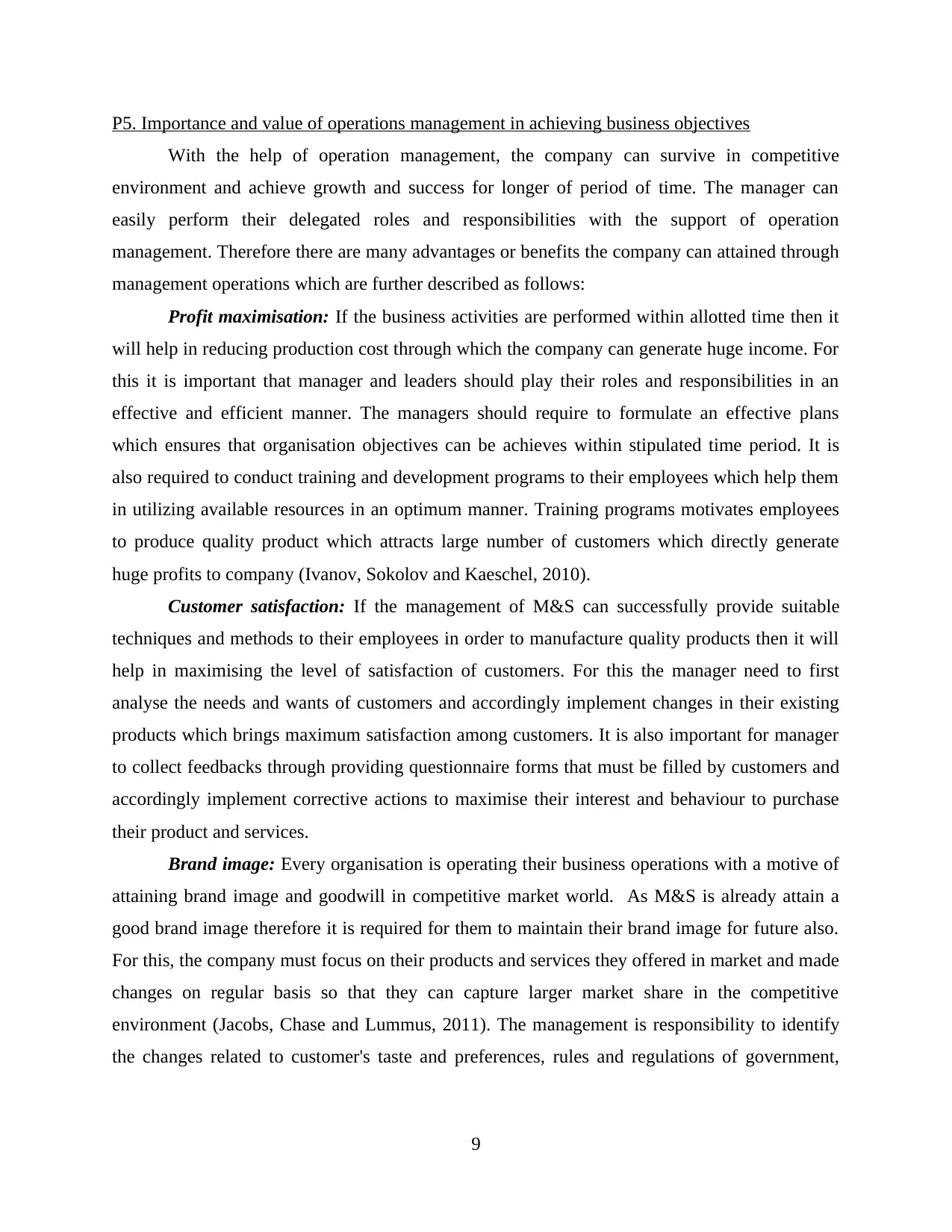
P5. Importance and value of operations management in achieving business objectives
With the help of operation management, the company can survive in competitive
environment and achieve growth and success for longer of period of time. The manager can
easily perform their delegated roles and responsibilities with the support of operation
management. Therefore there are many advantages or benefits the company can attained through
management operations which are further described as follows:
Profit maximisation: If the business activities are performed within allotted time then it
will help in reducing production cost through which the company can generate huge income. For
this it is important that manager and leaders should play their roles and responsibilities in an
effective and efficient manner. The managers should require to formulate an effective plans
which ensures that organisation objectives can be achieves within stipulated time period. It is
also required to conduct training and development programs to their employees which help them
in utilizing available resources in an optimum manner. Training programs motivates employees
to produce quality product which attracts large number of customers which directly generate
huge profits to company (Ivanov, Sokolov and Kaeschel, 2010).
Customer satisfaction: If the management of M&S can successfully provide suitable
techniques and methods to their employees in order to manufacture quality products then it will
help in maximising the level of satisfaction of customers. For this the manager need to first
analyse the needs and wants of customers and accordingly implement changes in their existing
products which brings maximum satisfaction among customers. It is also important for manager
to collect feedbacks through providing questionnaire forms that must be filled by customers and
accordingly implement corrective actions to maximise their interest and behaviour to purchase
their product and services.
Brand image: Every organisation is operating their business operations with a motive of
attaining brand image and goodwill in competitive market world. As M&S is already attain a
good brand image therefore it is required for them to maintain their brand image for future also.
For this, the company must focus on their products and services they offered in market and made
changes on regular basis so that they can capture larger market share in the competitive
environment (Jacobs, Chase and Lummus, 2011). The management is responsibility to identify
the changes related to customer's taste and preferences, rules and regulations of government,
9
With the help of operation management, the company can survive in competitive
environment and achieve growth and success for longer of period of time. The manager can
easily perform their delegated roles and responsibilities with the support of operation
management. Therefore there are many advantages or benefits the company can attained through
management operations which are further described as follows:
Profit maximisation: If the business activities are performed within allotted time then it
will help in reducing production cost through which the company can generate huge income. For
this it is important that manager and leaders should play their roles and responsibilities in an
effective and efficient manner. The managers should require to formulate an effective plans
which ensures that organisation objectives can be achieves within stipulated time period. It is
also required to conduct training and development programs to their employees which help them
in utilizing available resources in an optimum manner. Training programs motivates employees
to produce quality product which attracts large number of customers which directly generate
huge profits to company (Ivanov, Sokolov and Kaeschel, 2010).
Customer satisfaction: If the management of M&S can successfully provide suitable
techniques and methods to their employees in order to manufacture quality products then it will
help in maximising the level of satisfaction of customers. For this the manager need to first
analyse the needs and wants of customers and accordingly implement changes in their existing
products which brings maximum satisfaction among customers. It is also important for manager
to collect feedbacks through providing questionnaire forms that must be filled by customers and
accordingly implement corrective actions to maximise their interest and behaviour to purchase
their product and services.
Brand image: Every organisation is operating their business operations with a motive of
attaining brand image and goodwill in competitive market world. As M&S is already attain a
good brand image therefore it is required for them to maintain their brand image for future also.
For this, the company must focus on their products and services they offered in market and made
changes on regular basis so that they can capture larger market share in the competitive
environment (Jacobs, Chase and Lummus, 2011). The management is responsibility to identify
the changes related to customer's taste and preferences, rules and regulations of government,
9
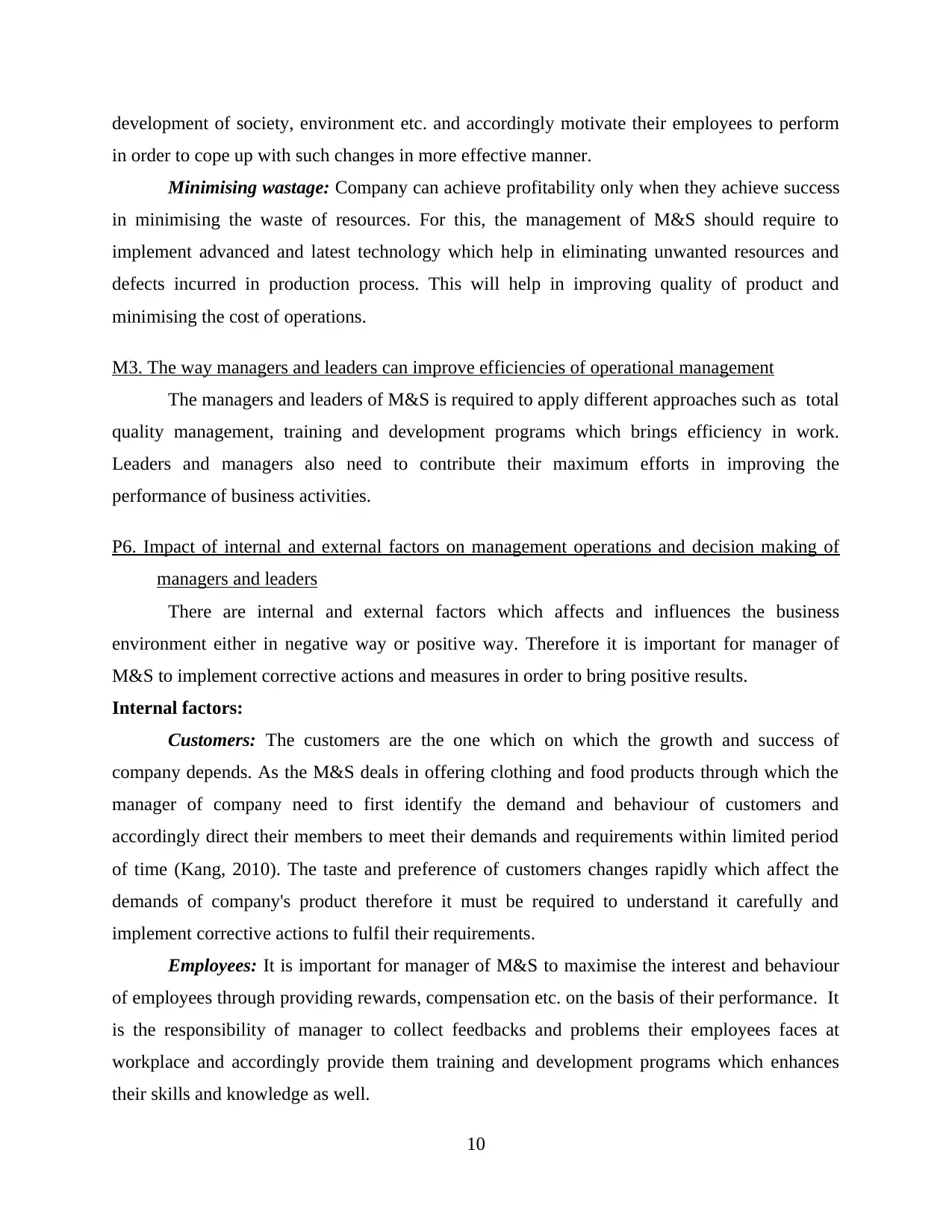
development of society, environment etc. and accordingly motivate their employees to perform
in order to cope up with such changes in more effective manner.
Minimising wastage: Company can achieve profitability only when they achieve success
in minimising the waste of resources. For this, the management of M&S should require to
implement advanced and latest technology which help in eliminating unwanted resources and
defects incurred in production process. This will help in improving quality of product and
minimising the cost of operations.
M3. The way managers and leaders can improve efficiencies of operational management
The managers and leaders of M&S is required to apply different approaches such as total
quality management, training and development programs which brings efficiency in work.
Leaders and managers also need to contribute their maximum efforts in improving the
performance of business activities.
P6. Impact of internal and external factors on management operations and decision making of
managers and leaders
There are internal and external factors which affects and influences the business
environment either in negative way or positive way. Therefore it is important for manager of
M&S to implement corrective actions and measures in order to bring positive results.
Internal factors:
Customers: The customers are the one which on which the growth and success of
company depends. As the M&S deals in offering clothing and food products through which the
manager of company need to first identify the demand and behaviour of customers and
accordingly direct their members to meet their demands and requirements within limited period
of time (Kang, 2010). The taste and preference of customers changes rapidly which affect the
demands of company's product therefore it must be required to understand it carefully and
implement corrective actions to fulfil their requirements.
Employees: It is important for manager of M&S to maximise the interest and behaviour
of employees through providing rewards, compensation etc. on the basis of their performance. It
is the responsibility of manager to collect feedbacks and problems their employees faces at
workplace and accordingly provide them training and development programs which enhances
their skills and knowledge as well.
10
in order to cope up with such changes in more effective manner.
Minimising wastage: Company can achieve profitability only when they achieve success
in minimising the waste of resources. For this, the management of M&S should require to
implement advanced and latest technology which help in eliminating unwanted resources and
defects incurred in production process. This will help in improving quality of product and
minimising the cost of operations.
M3. The way managers and leaders can improve efficiencies of operational management
The managers and leaders of M&S is required to apply different approaches such as total
quality management, training and development programs which brings efficiency in work.
Leaders and managers also need to contribute their maximum efforts in improving the
performance of business activities.
P6. Impact of internal and external factors on management operations and decision making of
managers and leaders
There are internal and external factors which affects and influences the business
environment either in negative way or positive way. Therefore it is important for manager of
M&S to implement corrective actions and measures in order to bring positive results.
Internal factors:
Customers: The customers are the one which on which the growth and success of
company depends. As the M&S deals in offering clothing and food products through which the
manager of company need to first identify the demand and behaviour of customers and
accordingly direct their members to meet their demands and requirements within limited period
of time (Kang, 2010). The taste and preference of customers changes rapidly which affect the
demands of company's product therefore it must be required to understand it carefully and
implement corrective actions to fulfil their requirements.
Employees: It is important for manager of M&S to maximise the interest and behaviour
of employees through providing rewards, compensation etc. on the basis of their performance. It
is the responsibility of manager to collect feedbacks and problems their employees faces at
workplace and accordingly provide them training and development programs which enhances
their skills and knowledge as well.
10
⊘ This is a preview!⊘
Do you want full access?
Subscribe today to unlock all pages.

Trusted by 1+ million students worldwide
1 out of 16
Related Documents
Your All-in-One AI-Powered Toolkit for Academic Success.
+13062052269
info@desklib.com
Available 24*7 on WhatsApp / Email
![[object Object]](/_next/static/media/star-bottom.7253800d.svg)
Unlock your academic potential
Copyright © 2020–2025 A2Z Services. All Rights Reserved. Developed and managed by ZUCOL.





